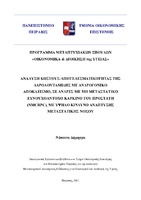Ανάλυση κόστους - αποτελεσματικότητας της δαρολουταμίδης με ανδρογονικό αποκλεισμό, σε άνδρες με μη μεταστατικό ευνουχοάντοχο καρκίνο του προστάτη (nmCRPC), με υψηλό κίνδυνο ανάπτυξης μεταστατικής νόσου
Cost-effectiveness analysis of darolutamide with androgen deprivation therapy for men with non-metastatic castration-resistant prostate cancer (nmCRPC) in high risk of progression

Προβολή/
Λέξεις κλειδιά
Καρκίνος του προστάτη ; Μη μεταστατικός ; Οικονομική αξιολόγηση ; Μοντέλο Markov ; Δαρολουταμίδη ; Prostate cancer ; Non-metastatic ; Economic evaluation ; Markov model ; QALYs ; ICER ; Darolutamide ; ADTΠερίληψη
Υπόβαθρο: Ο καρκίνος του προστάτη αποτελεί τον δεύτερο πιο συχνά διαγνωσμένο καρκίνο στον ανδρικό πληθυσμό παγκοσμίως. Οι βασικοί παράγοντες κινδύνου είναι η αύξηση της ηλικίας, η γενετική προδιάθεση και η εθνικότητα. Στον ευνουχοάντοχο καρκίνο του προστάτη (CRPC) οι ασθενείς έχουν πλέον αναπτύξει αντίσταση στη βασική θεραπεία καταστολής ανδρογόνων (ΑDT) και εμφανίζουν αύξηση στα επίπεδα του PSA. Μέχρι τη διάγνωση μετάστασης, οι ασθενείς υπόκεινται συχνά σε διαγνωστικές εξετάσεις, ενώ αντιμετωπίζουν ανεπιθύμητες ενέργειες από τον φαρμακευτικό ευνουχισμό. Τα τελευταία χρόνια μελετώνται νέες θεραπείες, οι οποίες στοχεύουν στην καθυστέρηση της εξέλιξης της νόσου και στη βελτίωση της
ποιότητας ζωής των ασθενών. Το Darolutamide είναι ένας νέας γενιάς αναστολέας των ανδρογονικών υποδοχέων, ο οποίος εγκρίθηκε το 2020 στην Ευρώπη για τη θεραπεία του μη μεταστατικού ευνουχοάντοχου καρκίνου του προστάτη (nmCRPC) σε άνδρες με υψηλό κίνδυνο ανάπτυξης μεταστάσεων. Σύμφωνα με την κλινική μελέτη ΑRAMIS, ο χρόνος επιβίωσης χωρίς μετάσταση (MFS) ήταν σημαντικά μεγαλύτερος με τη θεραπεία Darolutamide σε σχέση με το placebo σε ασθενείς με nmCRPC. Η σχέση κόστους-αποτελεσματικότητας του Darolutamide με ADT, σε σύγκριση με την ADT ως μονοθεραπεία σε άνδρες με nmCRPC, δεν έχει αξιολογηθεί στην Ελλάδα.
Στόχος: Σκοπός της παρούσας διπλωματικής εργασίας είναι η εκτίμηση της σχέσης κόστους-αποτελεσματικότητας της θεραπείας Darolutamide σε συνδυασμό με ADT, έναντι της μονοθεραπείας με ADT σε άνδρες με nmCRPC και υψηλό κίνδυνο ανάπτυξης μεταστάσεων στην Ελλάδα.
Μέθοδος: Η ανάλυση πραγματοποιήθηκε με τη χρήση του μοντέλου Markov υπό την οπτική γωνία του ελληνικού Εθνικού Συστήματος Υγείας και με χρονικό ορίζοντα όλη τη διάρκεια της ζωής των ασθενών (lifetime analysis). Το μοντέλο Markov περιλαμβάνει τρεις καταστάσεις υγείας: μη μεταστατικό στάδιο της νόσου, μεταστατικό στάδιο και θάνατος. Η εκτίμηση της αποτελεσματικότητας στην ανάλυση βασίστηκε στις καμπύλες Kaplan-Meier της κλινικής μελέτης ARAMIS και υπολογίστηκε σε όρους προσδόκιμου επιβίωσης σταθμισμένου για ποιότητα ζωής (QALYs). Η εκτίμηση του κόστους στηρίχθηκε σε ξένη βιβλιογραφία και προσαρμόστηκε σε ελληνικά δεδομένα τιμών. Τέλος, προκειμένου να αντιμετωπιστεί η αβεβαιότητα γύρω από ορισμένες παραμέτρους του μοντέλου, πραγματοποιήθηκε ανάλυση ευαισθησίας.
Αποτελέσματα: Η θεραπεία με Darolutamide εμφανίζει υψηλότερο κόστος ανά ασθενή, ενώ συγχρόνως αυξάνει τα ποιοτικά σταθμισμένα έτη ζωής, σε σύγκριση με το placebo. Ο δείκτης πρόσθετου κόστους-αποτελεσματικότητας (ICER) υπολογίστηκε 25.131,96€ ανά κερδισμένο QALY καθ’ όλη τη διάρκεια ζωής των ασθενών. Επίσης, η ανάλυση ευαισθησίας έδειξε ότι ο ICER είναι ευαίσθητος στις μεταβολές της τιμής του φαρμάκου και στο κόστος της παρηγορητικής θεραπείας. Συμπεράσματα: Σύμφωνα με τα αποτελέσματα της ανάλυσης, η θεραπεία Darolutamide με ADT σε σύγκριση με την ADT ως μονοθεραπεία, μπορεί να αποτελέσει μια οικονομικά αποδοτική επιλογή για τους άνδρες με nmCRPC και υψηλό κίνδυνο ανάπτυξης μεταστάσεων στο σύστημα υγείας της Ελλάδας.


